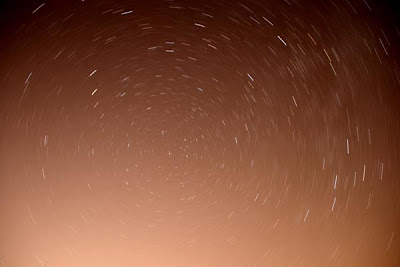 The rotation of the Earth around its axis aligned with the North Star is apparent in this picture. That is the North Star (Polaris) lower left of center; the one bright spot around which the other stars appear to be rotating.
The rotation of the Earth around its axis aligned with the North Star is apparent in this picture. That is the North Star (Polaris) lower left of center; the one bright spot around which the other stars appear to be rotating.This photo, a time exposure of about 10 minutes, was done hoping to capture one of the Perseid meteors Sunday night. Naturally, the longer the exposure, the greater the probability a meteor would fly through the picture.
However, another photographic problem begins to emerge. It is light pollution. That is the warm glow you see in the lower part of this picture. And, that light source is the city of Mansfield which is centered about eight miles north of the shooting location.
Increasing the length of the exposure increases the effect of the light pollution until ultimately the image is obliterated.
Successful pictures you see of these meteors then, are 1) shot in locations without the problem of light pollution, 2) done with equipment or by photographers more sophisticated--or lucky--than yours truly, or 3) likely done sometime closer to dawn when there was expected to be more meteor activity—and long after this geriatric photographer’s bedtime.

No comments:
Post a Comment